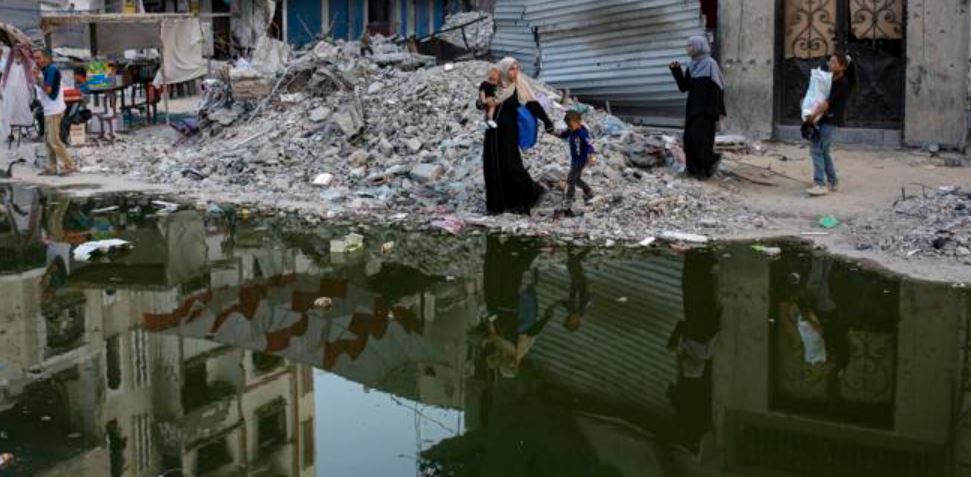Protestors Demand Ceasefire in Israel’s Nine-Month Conflict
Amidst the prolonged turmoil marking nine months of war in Gaza, Israeli citizens took to the streets in a powerful display of dissent. On July 7, highways across Israel were blocked by protesters demanding Prime Minister Benjamin Netanyahu’s resignation and a ceasefire to secure the release of hostages held by Hamas. This unrest underscores the escalating public frustration and the dire need for a resolution to the ongoing conflict.
National Mobilization: A Call for Leadership Change
The demonstrations, labeled a “Day of Disruption,” commenced at 6:29 A.M., coinciding with the precise moment Hamas militants initiated their first rocket attacks in October. Protesters, waving Israeli flags, clogged major roads and gathered outside the residences of Knesset members, signaling widespread discontent with the government’s handling of the crisis. The visual imagery of the protests was striking, with 1,500 black and yellow balloons released near the Gaza border symbolizing those killed or abducted.
International Mediation Efforts
In a significant development, international mediators have intensified their efforts to broker a ceasefire. Over the weekend, Hamas appeared to retreat from its previous demand for an Israeli commitment to end the war, according to Egyptian and Hamas officials. This potential shift could pave the way for renewed negotiations, although a definitive agreement remains elusive.
Background of the Conflict
The conflict, which erupted following a cross-border assault by Hamas on October 7, has resulted in substantial casualties. The initial attack led to the deaths of 1,200 Israelis and the abduction of 250 others. In retaliation, Israeli air and ground offensives have killed over 38,000 Palestinians, as reported by Gaza’s Health Ministry. The Ministry’s figures do not differentiate between combatants and civilians, highlighting the extensive human toll.
Humanitarian Crisis: Ongoing Strife and Casualties
On Sunday, the conflict’s brutal reality persisted with nine Palestinians killed by Israeli airstrikes. Notably, six Palestinians perished in central Gaza when a strike hit a house in Zawaida, and another three were killed in a strike west of Gaza City. The previous day, an Israeli airstrike on a school-turned-shelter in the Nuseirat refugee camp resulted in at least 16 deaths and over 50 injuries.
Escalation in Northern Israel
In a concerning escalation, Hezbollah launched a barrage of projectiles towards northern Israel, targeting areas more than 30 kilometers from the border. This marked a significant intensification, raising fears of a broader regional conflict. The Israeli military retaliated with an airstrike that killed a Hezbollah engineer, exacerbating tensions further.
Hostage Crisis: Desperate Pleas for Resolution
The hostage crisis remains a critical issue, with approximately 120 individuals still in captivity. Although more than 100 hostages were released as part of a November ceasefire deal, over 40 are presumed dead. The Israeli government has acknowledged the grim reality that the number of fatalities may increase as the conflict continues.
Voices of Protest: Public Outcry
Hannah Golan, a protester, voiced her anguish over the government’s inaction, stating, “It’s nine months today, to this black day, and still nobody in our government takes responsibility.” Her sentiments were echoed by many who feel abandoned and demand accountability from their leaders. The collective outcry is a poignant reminder of the human cost of this prolonged conflict.
Prospects for Ceasefire: Diplomatic Efforts
Mediators from the United States, Egypt, and Qatar have stepped up their efforts to secure a ceasefire. Hamas’ recent willingness to compromise could facilitate the first pause in fighting since November. The proposed phased deal involves a six-week ceasefire, during which hostages would be exchanged for Palestinian prisoners. Israeli forces would withdraw from densely populated areas of Gaza, allowing displaced individuals to return home.
Pessimism Among Gaza’s Residents
Despite these diplomatic endeavors, many in Gaza remain skeptical about the prospects for peace. Heba Radi, a displaced Palestinian woman, expressed her despair, saying, “Every day, we tell ourselves tomorrow there will be a ceasefire, and tomorrow will be better. And when tomorrow comes, they say the negotiations were postponed.”
Appeal for Humanitarian Aid
The ongoing conflict has severely hampered humanitarian aid efforts, leading to widespread hunger and fears of famine. The top U.N. court has raised alarms about a plausible risk of genocide in Gaza, a charge that Israel vehemently denies. The international community continues to call for urgent measures to alleviate the suffering and restore some semblance of normalcy for the war-weary population.
Conclusion: The Need for Resolution
As the conflict drags on, the urgency for a sustainable resolution grows. The persistent protests in Israel reflect a nation yearning for peace and stability. International mediation efforts, while promising, must swiftly translate into tangible outcomes to halt the cycle of violence. The voices of those affected by the conflict—both in Israel and Gaza—highlight the profound human desire for peace and the imperative for decisive, compassionate leadership.
Summary:
| Key Learning Points |
|---|
| Protests in Israel demand Netanyahu’s resignation and ceasefire. |
| Hamas shows potential willingness to negotiate. |
| Conflict originated from Hamas’ attack in October 2023. |
| Significant casualties on both sides, with ongoing airstrikes. |
| International mediators seek to broker a ceasefire deal. |
| Hostage crisis remains a critical issue in the conflict. |
| Humanitarian aid efforts in Gaza are severely hindered. |
Soumya Smruti Sahoo is a seasoned journalist with extensive experience in both international and Indian news writing. With a sharp analytical mind and a dedication to uncovering the truth, Soumya has built a reputation for delivering in-depth, well-researched articles that provide readers with a clear understanding of complex global and domestic issues. Her work reflects a deep commitment to journalistic integrity, making her a trusted source for accurate and insightful news coverage.



